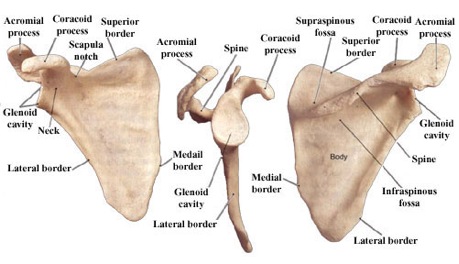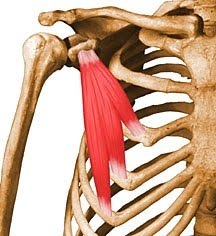As one of the most mobile joints in the body, the shoulder can also be one of the most complicated to understand and work with. To paraphrase a comic book line: "With great mobility comes great complexity." With this complexity and mobility also comes injury potential and the need to properly coordinate this amazing set of structures.
There are four different joint structures that influence the shoulder: the sternoclavicular joint (SC joint), the glenohumeral joint (GH joint), the acromioclavicular joint (AC joint), and the scapulothoracic articulation. The SC joint is the only body attachment of the shoulder to the body and this gliding "saddle" joint is crucial to shoulder health and function. The GH joint is classically what is considered the shoulder joint because that is where all the visible motion happens. The AC joint is how the scapula (shoulder blade) and clavicle join and only becomes an issue if sprained or if there is a bony growth off of it. The scapulothoracic articulation is where the scapula glides, rotates, and moves on the rib cage (thoracic area). This is where a great deal of muscle activation and patterning goes wrong.


Also realize that there are a rather large number of muscles involved in the functioning of the shoulder girdle. Along with the four muscles of the rotator cuff, deltoid, trees major, Latissamus dorsi, pectoralis major and minor, serratus anterior, serratus posterior, Rhomboids, Upper and lower Trapezius, you could also consider the muscles of respiration, the muscles of the neck, and even the "core".
(Anatomy images from begin2dig.com)
This muscular picture gets far more complicated if you delve into Anatomy Trains by Thomas Myers. Anatomy Trains details the ever developing understanding of the fascial, muscular and connective tissue systems and how they all interact. There are two excellent examples that relate directly to understanding the shoulder and shoulder packing. In Anatomy Trains, Myers discusses how the Rhomboids and the Serratus Anterior are essentially the same muscle. Our muscular and fascial system is basically white fiber at the attachments/origins and red fiber in the middle and while we would like these white fiber attachments/origins to provide clear borders and separations for muscles (to make it easy for us to name them) the reality is quite different. In the Serratus Anterior and Rhomboids it means that the rhomboids originates on the spine, attaches to the vertebral border of the scapula and then flows underneath the scapula becoming the serratus anterior and attaching on the digitations of ribs 2-8. (Or does it flow the other direction????)
Now both of these muscles have important functions regarding scapular stability and rotation and can "function" independently of one another to an extent but if you pull on one end of the muscle you influence the other so it is a complicated interplay.
The other example is the shared fascial attachments of the Teres Major and the Latissimus Dorsi (Lats). The Lats are very large and arise from the Thorocolumbar fascial and lumbar area flowing up the back, along the lateral border of the scapula (some people even have a lat attachment on the inferior angle of the scapula but this is becoming more and more rare within the human species) where it shares a fascial junction with the Teres Major (which arises from the posterior surface of the scapula). Once the Lat and Teres Major "split" ways and go to their respective attachments (teres major stays posterior and attaches on the humerus and the lats flow under the humerus and wrap around attaching to the humerus slightly more anterior in the same region of the humerus). The shared fascial attachment then splitting and have a posterior attachment and then the wrap around and more anterior attachment produces a unique force coupling mechanism responsible for a distal support influencing anterior containment of the shoulder capsule, rotation of the humerus, and "packing" of the shoulder.
How much of this do you need to delve into and how many layers deep do you need to go before you can understand the anatomy and mechanics? I will simple quote Pavel, from Power to the People, "understanding is a delaying tactic - the drowning person does not want to understand fluid dynamics - they just want to not drown." So don’t get bogged down in the specifics - rather apply the information immediately. You will have a rainy day where you can study.
Without trying to write a dissertation on the shoulder (and complete books have been written on this area of the body) we will try to focus on two shoulder positions, the packing for the classic overhead position and the packing of the shoulder during the Hanging Leg Raise.
The classic overhead position can be simply thought of as the finish of a Military Press or Kettlebell Snatch. Elbow straight, bicep in line with but not touching the ear, shoulder down away from the ear and the overall body structure/posture aligned so that a weight held overhead is centered through the body into the ground. The movement to achieve that position is where the magic happens.
Simply by raising the arm from your side to about parallel to the ground (30 degrees) the main activation and packing of the shoulder occurs at the GH joint as the rotator cuff fires first and stabilizes the head of the humerus in the glenoid fossa. Scapular stability is maintained and there isn’t much scapular motion up to this level. Past 30 degrees and overhead the scapula and glenoid share a 2:1 ratio of movement where the scapular rotation is controlled by coordinating the Upper, Middle and Lower trapezius along with the rhomboids and serratus anterior. (
http://moon.ouhsc.edu/dthompso/namics/scapryme.htm) Ideally the scapula maintain a retracted, and depressed position while rotating appropriately.
Some people will hear the term packing the shoulder and immediately think of immobilizing the shoulder. This is not the case. Just as stability does not mean immobility but rather means motor control over a range of motion. Shoulder packing in regards to the scapula means a "sticky" scapula that does not "wing", or elevate but rather is stabile and rotates correctly.
I would be remiss if I did not mention that the ability of the scapula to pack correctly and rotate correctly is based off of a mobile thoracic spine. A degree of thoracic extension is necessary for the scapula to not give up its position and function. Cervical spine mobility and health come into play any time the shoulder/t-spine is in play so the interconnectedness continues....
Image from HardStyle Abs
Obviously the Hanging Leg Raise (HLR) assumes that you can obtain a proper overhead position as described above. For that to happen the 4 joints listed in the beginning and the rather large number of muscles must do their respective "jobs" efficiently. So we will assume that the rhythm of glenoid movement to scapular rotation (a 2:1 ratio) is correct and that there is no impingement or pain.
Packing the Glenohumeral joint begins when the rotator cuff fires and pulls the head of the humerus over the lip of the labrum (shoulder cartilage) and produces the force coupling mechanism that allows for proper rotation of the humerus on the glenoid fossa without elevation and impingement of the rotator cuff in the sub acromial space. Since you will be hanging from this joint and producing a solid "base" in the upper body for the production of strength from the abdominals etc., this packing of the GH joint is crucial. If you don’t pack the GH joint and allow it to "hang lose", you risk impingement and labral (cartilage) damage as you try to stabilize the upper body for the HLR.
Perhaps the best cue for packing the GH joint is to "suck the shoulder into the body".
Proper position, packing and activation of the Scapulothoracic articulation is unique in the HLR. Typically we want to prevent elevation and only allow proper rotation of the scapula producing depression and retraction of the scapula but in the HLR we will be adding a couple of key components. Since you are already in the overhead position grasping the bar with the proper grip we are again assuming that you got there in the proper manner: ie... packed GH joint, glide from the SC joint, and proper scapulothoracic rhythm. If the Scapulothoracic area does not pack and is allowed to elevate in this exercise there will be a host of consequences including: impingement of the nerves and blood vessels in the neck and brachial plexus region, and loss of GH packing and impingement.
So step one and perhaps the best cue for packing the scapulothoracic articulation and creating the retraction and depression initially is to "get your shoulders as far down away from the ears as possible".
Once that is done the setting of the overhead gymnastics "hollow" position (described by Pavel) by protracting the scapula and activating the lats performing a "straight arm pull-down" maneuver can be performed safely. The cue for this is to have the feeling of performing a straight arm pull-down or "pushing yourself away from the bar with straight arms".
Remember that in order to build a stable base with the upper body hanging from the bar for the HLR packing the GH joint and finding the "hollow" position with protracted but not elevated scapula is essential. Once the upper body and rib cage are set in this position the abdominals, hips and "core" musculature will be able to perform a proper HLR. Otherwise you will likely punish the shoulders and have a weak HLR.